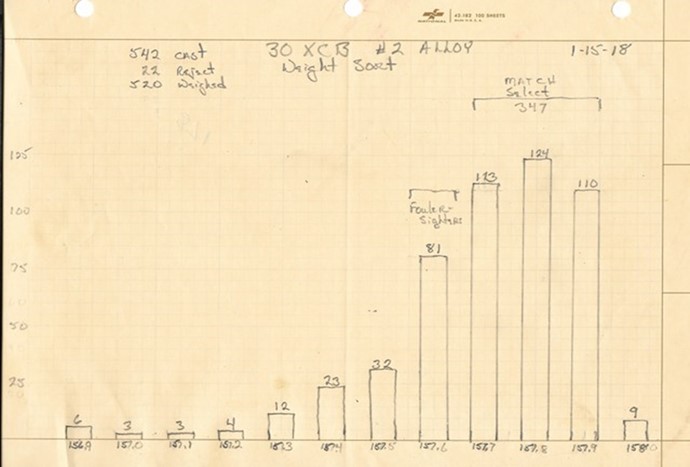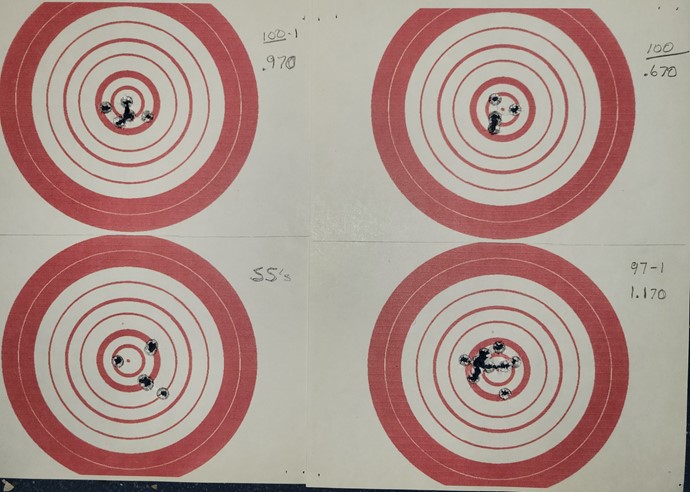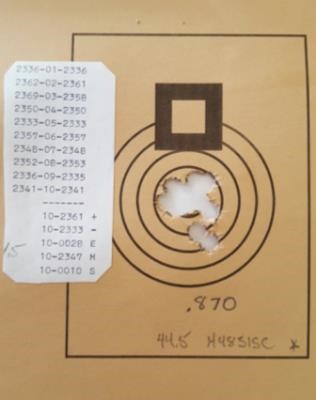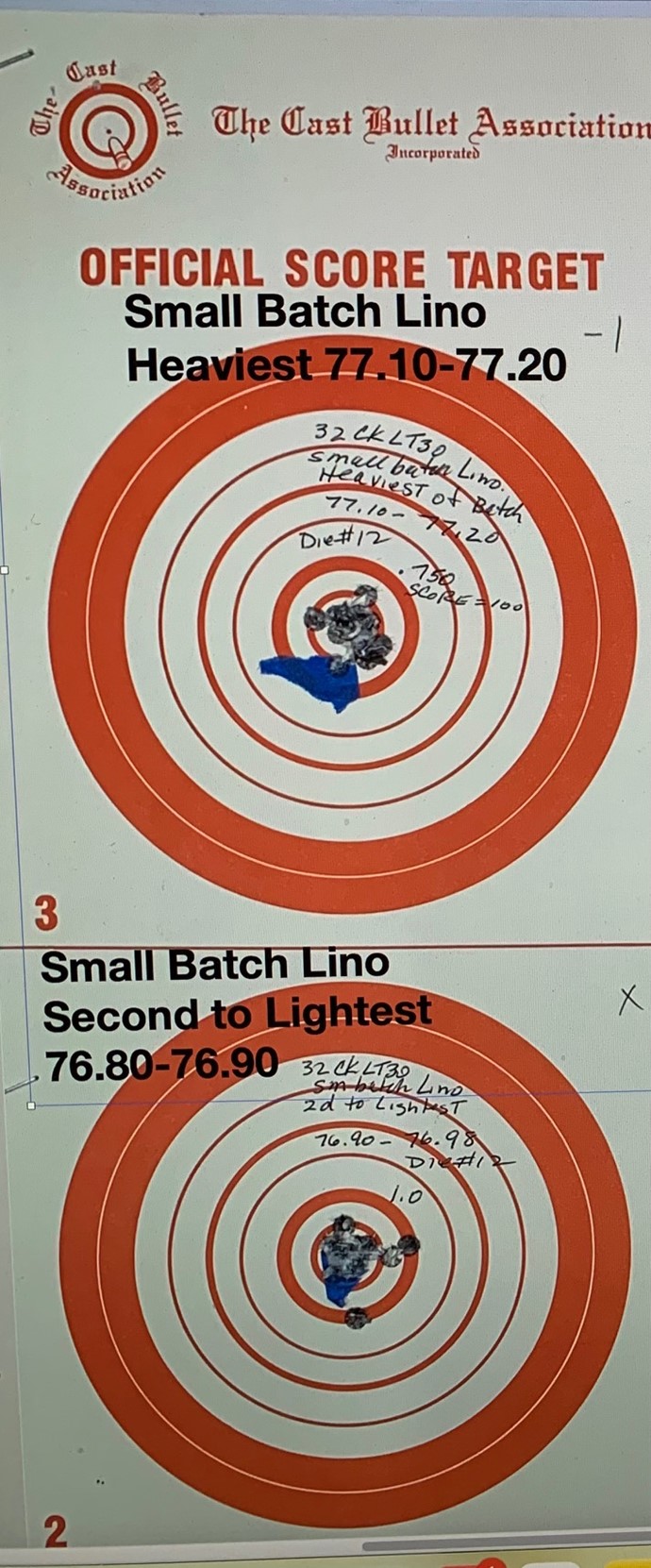This test was conducted early on several years back as I was refining my casting technique, wring out the 30 XCB bullet and developing the high velocity loads. Keep in mind this rifle is not of "match" quality or configuration as per the description in the first paragraph. This was the first test of weight sorted 30 XCB bullets.
Weight Sort Test; 30 XCBs of #2 Alloy
In previous posts I posted the graphed results of weight sorting a recently cast batch of 30 XCBs (NOE 310-165-FN 4 cavity aluminum mould). They were cast of Lyman #2 alloy and were WQ’d out of the mould. These were loaded in the 30x60 XCB cartridge with the standard HV load of 53 gr AA4350. That give 2900 fps out of the test rifle; a 31” Broughten Palma contoured barrel with a 16” twist on a BRNO VZ24 Mauser action. The rifle has a Leupold 6.5x20 target scope on it. This rifle was not made for BR shooting. It was made for HV cast bullet shooting to determine how fast a ternary cast bullet could be pushed while maintaining 2 moa accuracy (10 shot groups) linearly to 300+ yards. That goal was achieved. The rifle with weight sorted select 30 XCB bullets will hold 1 to 1 ½ moa accuracy (10 shot groups) to a tested 400 yards (so far).
Let’s keep in mind before we post I shoulda, coulda, woulda tested this many or that many of this or that using different 5 or 10 shot tests of each, etc. that in this batch of 542 cast XCBs there were just only so many of some weights. The number of each weight is on the previously posted graph and listed in the post. The number of some weights, particularly the lower weights, was finite. There were only so many to test….period. Thus I made some judgments on how many each would be a “group”. I strived for 10 shot groups but that was not possible with some weights.
I use the Lyman lino/lead/tin formula to mix #2 alloy. Since I mix my own #2 alloy I’ve found over casting and weight sorting 5,000+ of the 30 XCBs that different batches of #2 alloy usually produce slightly different weights of bullets. In this test I had used a different source of linotype (a pig bar) from the previous batch made with type. The result is that the bullets in this test weighed and average of 1.5 gr less than the previous batch’s 30 XCBs. There was little difference iif any in accuracy or velocity with the slightly lighter weight new XCBs. The previously used weight sorted select XCBs weighed 164 gr fully dressed while the new ones weighed 162.5 gr.
The test was conducted yesterday at a range of 100 yards. Nine test groups were fired plus a sighter target. The barrel was allowed to completely cool and was cleaned between every 3 test groups. One fouler was shot and then the subsequent shots would “go to group” centered on the CBA target. The “foulers were all shot with the heaviest weight sorted select bullets (157.9 gr.) and since it was obviously zeroed no adjustments were made throughout the test to elevation or windage. Each test group was shot with that zero aiming at the center “X” dot.
The fouler/sighter target;
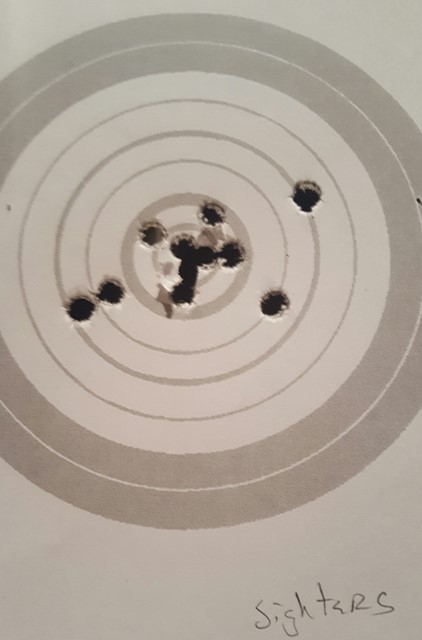
The first test was with the visually rejected bullets. These bullets were not weighed but had a visual defect (wrinkle, rounded GC shank, cavities in surface, frosted area on the side). The 10 shots group size was 2.280”. Only 2 of those 10 would have “gone to group”. All the other 520 bullets of this batch passed my anal visual inspection.
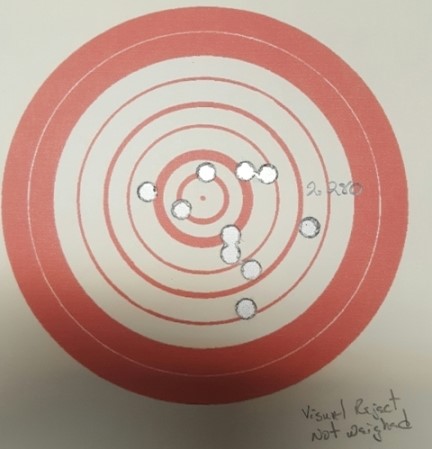
There were 5 bullets that were visually perfect yet weighed considerably lighter than the rest (155.2 to 156.9 gr). These were tested by themselves. As we see from the dispersion from the group had they not been weight sorted out they could have had a disastrous effect on a CBA score, particularly 2 of them. The 5 shots went into 3.317”.
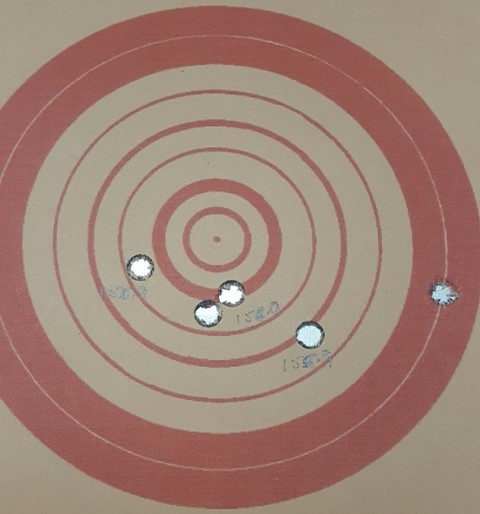
The next test combined 2 weights (156.9 [X]and 157.0 [O]) as there were only 6 of one and 3 of the other. Each weight was tracked on target and is so marked (“X” and “O&rdquo . The 9 shots went into 1.620”
. The 9 shots went into 1.620”
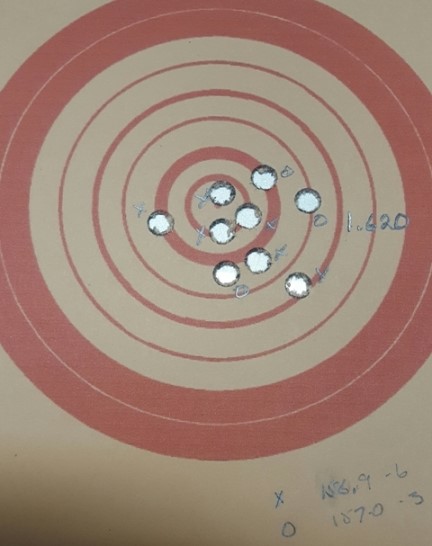
Again I combined 2 weights as there was only 3 of the 157.1 gr and 4 of the 157.2 gr XCBs. The seven shots went into 1.515”. That gives a fairly good indication that accuracy is improving as the bullets get heavier. Again the different weights were tracked on target with “X” and “O”.
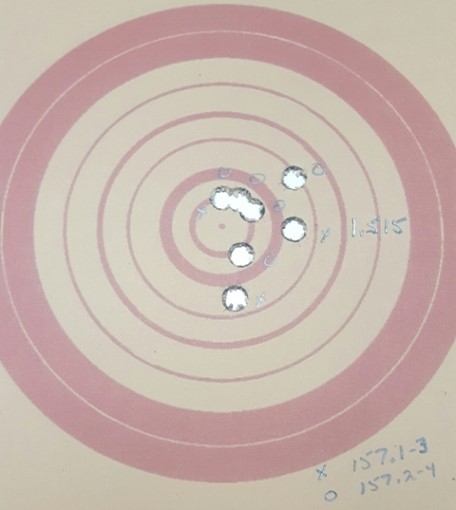
Just when things were going good a guy shows up to test a prototype (they make them here in Lake Havasu) AR in 30-06. It had a 16” barrel with a horrendous muzzle brake. He parked himself on a bench 4 down from me. Every time he shot it felt like a grenade going off next to me. I had to put plugs in my ears plus the muffs over my ears. I tried shooting between his shots but I still managed to flinch off a shot of two as the test progressed. If that happened I called the shot (all went to call) and marked it. Thankfully I had at least 10 shots for the remaining group tests or additional loaded to get a 10 shot group.
The 157.3 weight put 6 of the 10 shots “to group”. There was 1 call in this group. Group size is 1.555” without the call shot.
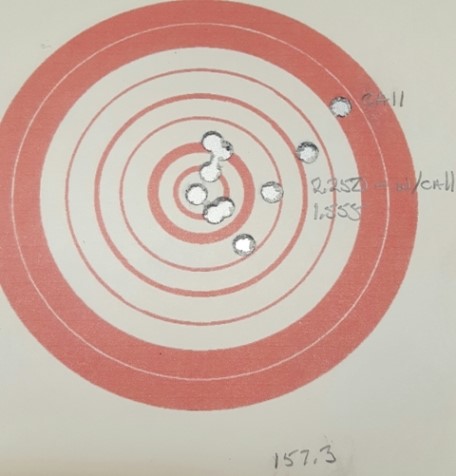
The next weight, 157.4 gr, grouped into 1.750” for 9 shots. There was one definite called shot (ok, I flinched it off…&hellip .
.

As the bullets get heavier and are more completely filled out the groups are beginning to get better and to center back up on target. With the 157/5 gr bullets there was also one call but the rest went into 1.371” with more shots beginning to cluster.
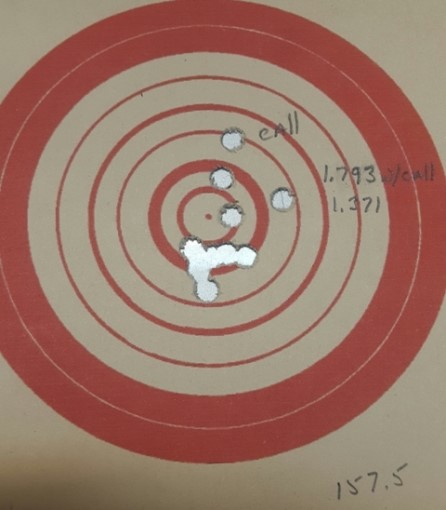
The next test is with a mix of 157.6 gr (3), 157.7 gr (3) and 157.8 gr (4). These are tracked separately on target. Looking back at the graph in the previous post the 157.6 gr were selected to be “foulers/sighters” so I wanted to see how they would hit compared to the “select” weights of 157.7 gr and 157.8 gr. Their impact over lapped the heavier weights. The 10 shots went into 1.267”

Here are the chronograph statistics from the last 30x60 weight sort test session. There was only 7 shots chronographed of the sighters as that amount showed the zero was centered on the CBA target. Additionally there was another with just 7 shots, two with 5 shots, a 9 shot and a 12 shot test.
The load used gives 2900+ fps at 80+ degrees. As we see here with the "select bullets" the average velocity was 2886 fps. The temperature during the test session was 45 - 60 degrees which accounts for the slightly lower velocity.
Bullet Wt Aver Vel SD ES #shots
Sighters (157.7/.8/.9) 2883 18 51 7
Vis Def 2876 13 46 10
Lites 2847 6 15 5
157.9/157.0 2870 22 57 9
157.1/157.2 2859 11 31 7
157.3 2852 13 48 10
157.4 2833 22 77 10
157.5 2831 15 52 10
157.6/.7/.8 2876 21 65 12
157.7/.8/.9 2886 14 39 10
The next test was with the weight sorted XCBs loaded over my match load in the .308W to test in my M70 Match rifle. This is the rifle I use in the “Commercial Rifle” (CBA BR Matches) matches over at Ben Avery Range with the Phoenix CBA bunch. This rifle also has a Leupold 6.5x20 Target scope on it.
This first target is with a mix of the 3 top weights (157.7 gr, 157.8 gr. 157.9 gr) with 3 each of the first 2 and 4 of the last. This group includes the foulers out of the clean barrel as they go very close to group. The first 3 foulers are marked and shots 4 through 10 then went into one small cluster of .584”. The overall group including the foulers is 1.031”
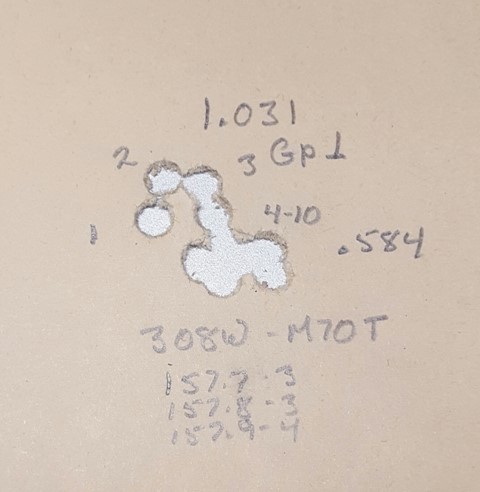
The scope elevation was then adjusted down 3 moa to get close to the aiming point. The next group was with 4 shots each of the 157.8 gr and the 157.9 gr along with the 2 remaining lighter weight sorted out 157.3 gr XCBs. They were mixed when loaded so the test was “blind” so to speak. The group size was 1.692” with 8 shots going into .892”. Wonder which 2 shots were the lighter weight bullets…..?
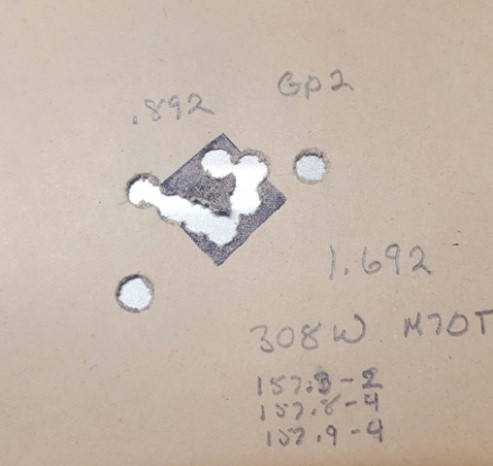
Lastly, I graphed out the nine 30x60 XCB tests by bullet weight and group size. This gives us a “visual” comparing the group sizes vs. the weight increments. Between the graph and the actual on target performance it is pretty obvious that weight sorting is beneficial to increased accuracy.
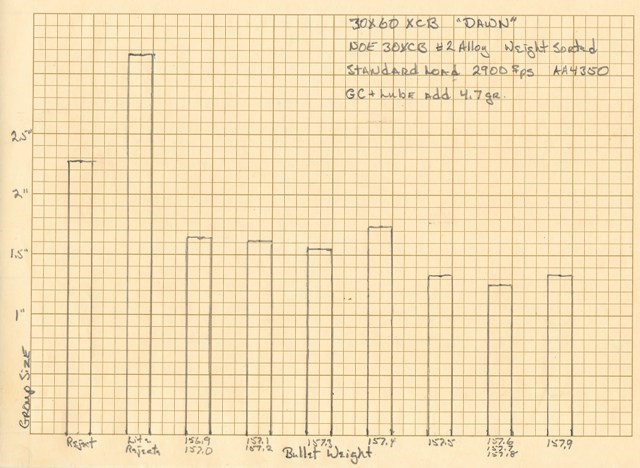
That was the first actual testing I did with the 30 XCB bullet in both rifles. The results here led to the further testing and results already posted. As we see, there was a lot of shots in a lot of groups. I'm not sure more 'testing" will give any more "surety" but I'm open to reasonable suggestions?
LMG
Concealment is not cover.........














